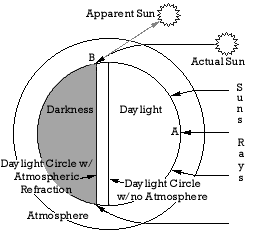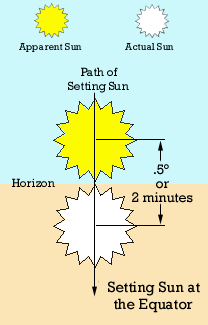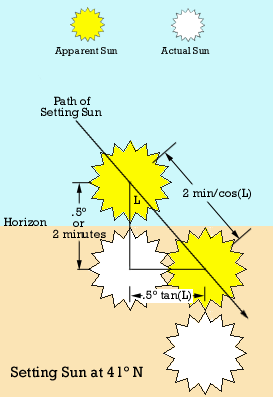
At every turn of the seasons, discussion in my classes turns to the length of the daylight period and sunrise and sunset times that don't agree with what students have been taught to expect. For instance, I demonstrate and explain in my classes that the length of the daylight period is everywhere 12 hours on the Equinoxes, yet a check of published rise and set times always reveals a longer daylight period. How can the discrepancy be explained and quantified?
Earth's atmosphere causes refraction of the sunlight that passes through it. Near the horizon, refraction will raise an object on the horizon (like a star or the Sun) to an apparent position about 0.5° above the horizon (when the 'bottom' of the Sun is raised more than the 'top', the rising or setting sun can look quite flat). More variable local atmospheric effects, like the Novaya Zemyla Effect, can increase the effect of the refraction by an order of magnitude or more! This refraction effectively hastens the apparent rising of the Sun and delays the apparent setting of the Sun. Figure 1 presents a simple qualitative explanation of the refraction induced lengthening of the daylight period. This composite image presents an interesting view of the setting moon viewed from earth orbit.
 |
FIGURE 1. If Earth had no atmosphere, the Daylight Circle (the boundary between night and day) would divide Earth exactly in half. But sunlight (and starlight, and Moonlight) entering Earth's atmosphere is refracted as it passes through the atmosphere on its way to the surface of Earth. When the Sun is nearly overhead (at A) the refraction is negligible. Near the horizon at B (where sunlight strikes the atmosphere at a low angle and must travel through significantly more air to reach Earth's surface), atmospheric refraction can raise the actual position of an object on the horizon to an apparent position 0.5° or more above the horizon. This effect 'moves' the Daylight Circle into the night (to the left in the diagram) effectively causing slightly more than one half of Earth to be illuminated, and thereby lengthens the daylight period that simple geometry would otherwise nicely predict. |
Conveniently, the diameter of the Sun is also about 0.5°, so atmospheric refraction raises the actual Sun that is just below the horizon to an apparent position that is just above the horizon. The refraction induced early rising and late setting of the Sun, then, lengthens the daylight period by (nearly) the amount of time it takes the Sun to rise and to set, and that time depends partially upon the observer's latitude.
(NOTE: The US Naval Observatory computes sunrise and sunset times using a refraction of 0.533° and a Solar diameter of 0.566° (see the USNO technical details page for more on this). By rounding to 0.5° for both values, daylight periods calculated on this page will be a little shorter than those provided by the Naval Observatory, with the differences being greater at higher latitudes.)

Information provided for longitude 0.0, latitude 0.0
Wednesday, 20 March 2002 Universal Time
Begin civil twilight 05:44
Sunrise 06:05
Sun transit 12:08
Sunset 18:11
End civil twilight 18:32

Information provided for New York, New York W73.9, N40.7
Wednesday, 20 March 2002 Eastern Standard Time
Begin civil twilight 5:32 a.m.
Sunrise 6:00 a.m.
Sun transit 12:04 p.m.
Sunset 6:08 p.m.
End civil twilight 6:36 p.m.